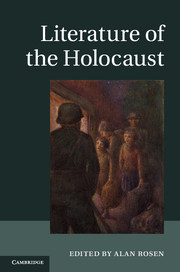Book contents
- Frontmatter
- Contents
- Notes on contributors
- Acknowledgments
- Introduction
- Part I Wartime victim writing
- Part II Postwar responses
- Part III Other approaches
- Chapter 12 Oral memoir and the Shoah
- Chapter 13 Songs of the Holocaust
- Chapter 14 Sephardic literary responses to the Holocaust
- Chapter 15 Anthologizing the Holocaust
- Chapter 16 The historian’s anvil, the novelist’s crucible
- Guide to further reading
- Index
- References
Chapter 15 - Anthologizing the Holocaust
Published online by Cambridge University Press: 05 June 2014
- Frontmatter
- Contents
- Notes on contributors
- Acknowledgments
- Introduction
- Part I Wartime victim writing
- Part II Postwar responses
- Part III Other approaches
- Chapter 12 Oral memoir and the Shoah
- Chapter 13 Songs of the Holocaust
- Chapter 14 Sephardic literary responses to the Holocaust
- Chapter 15 Anthologizing the Holocaust
- Chapter 16 The historian’s anvil, the novelist’s crucible
- Guide to further reading
- Index
- References
Summary
Holocaust anthologies, notes one editor, are something of a contradiction in terms. Since the root meaning of anthology “is a collection of flowers, a thing of joy and beauty,” such a collection could only be titled “flowers of evil” – with a nod toward Baudelaire’s very different collection of poems by this name.
Most editors have not explicitly pointed to the etymological tension. But the problem of classifying what a Holocaust anthology is, or should be, may find expression in the practical exigencies of the library catalog. The United States Library of Congress, for example, doesn’t use the heading “literary anthologies” at all, preferring “literary collections.” The Yad Vashem library, which relies on a different cataloging system, forgoes “literary collections,” grouping all collections, literary and otherwise, simply under “anthologies.” These rubrics are harbingers of blurred lines and hybrid assortments: Holocaust literature anthologies vary considerably, most often also contain non-literary writings, and resist uniform classification – which can make locating them a challenge.
- Type
- Chapter
- Information
- Literature of the Holocaust , pp. 238 - 251Publisher: Cambridge University PressPrint publication year: 2013

